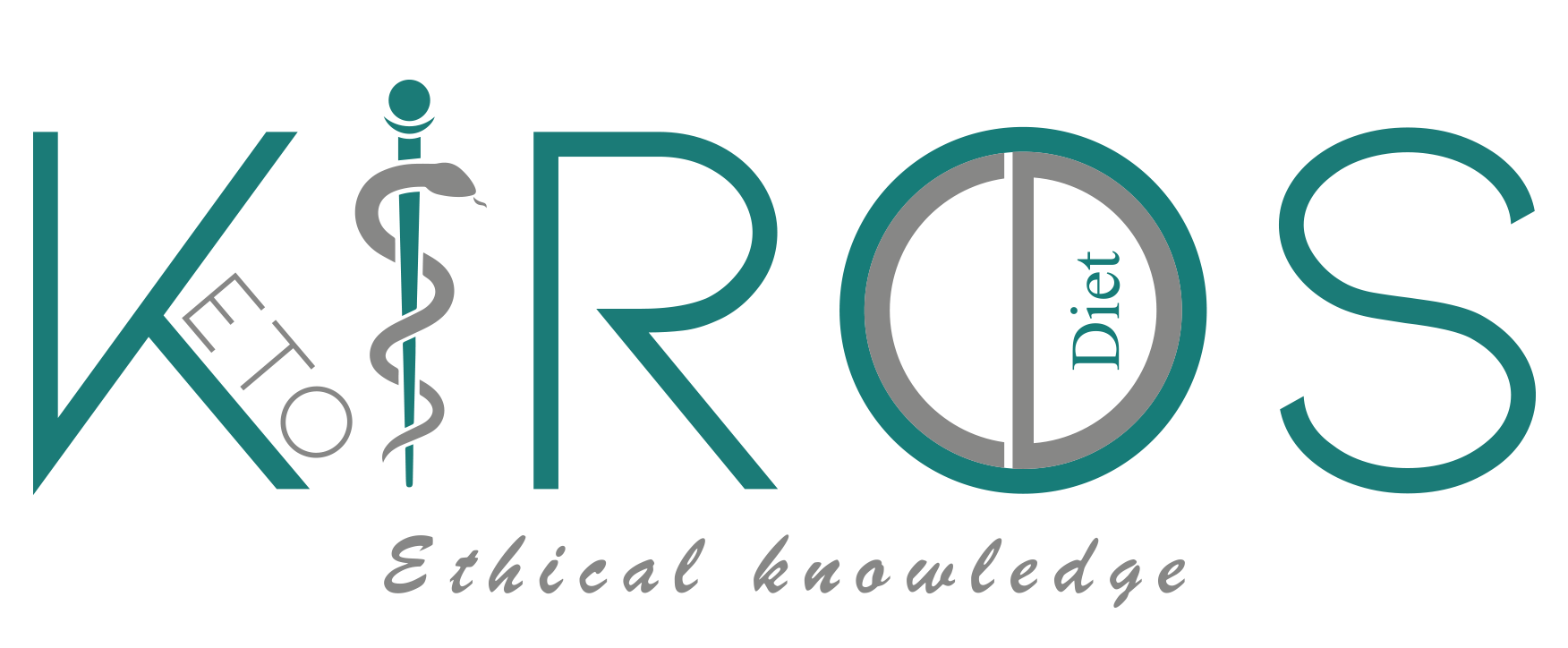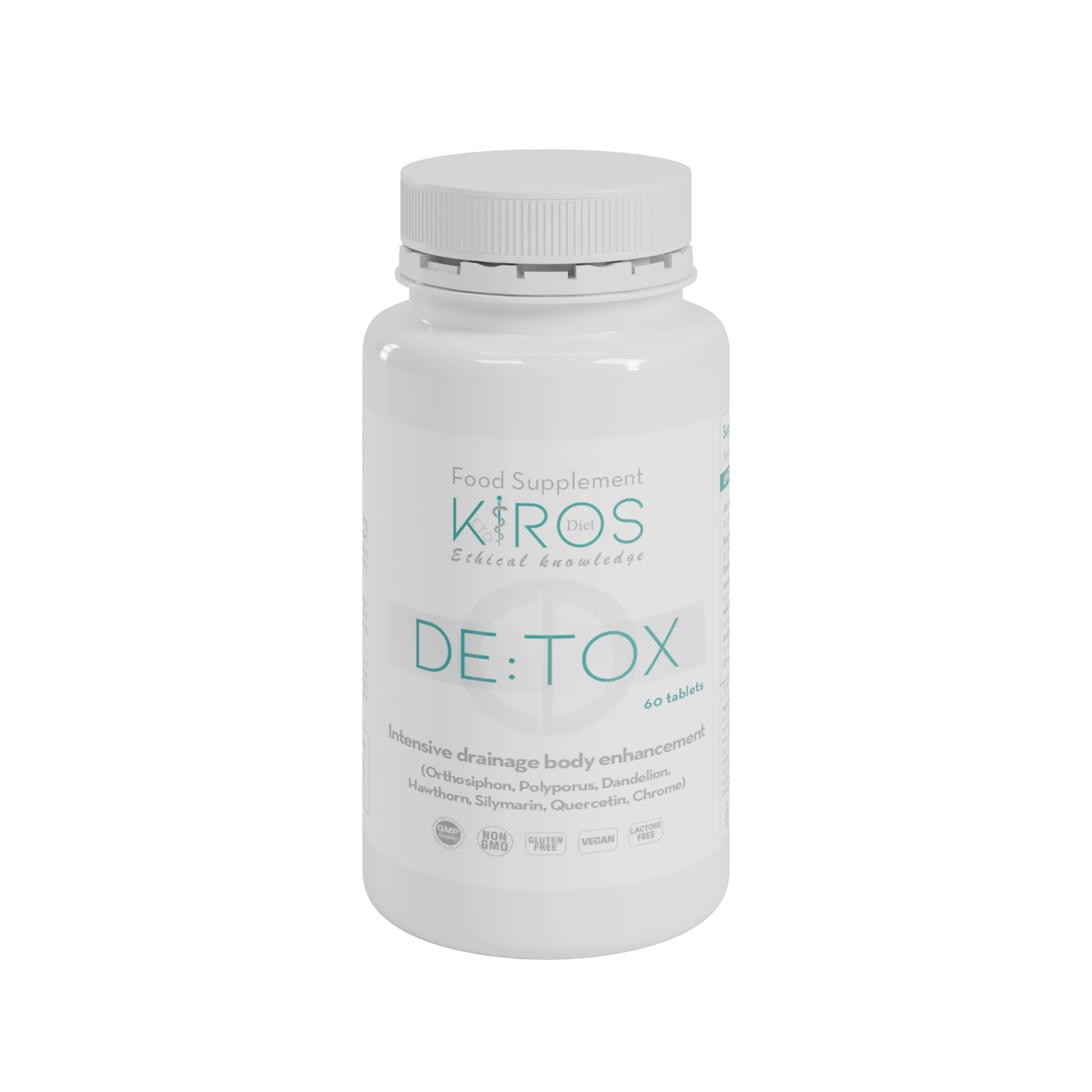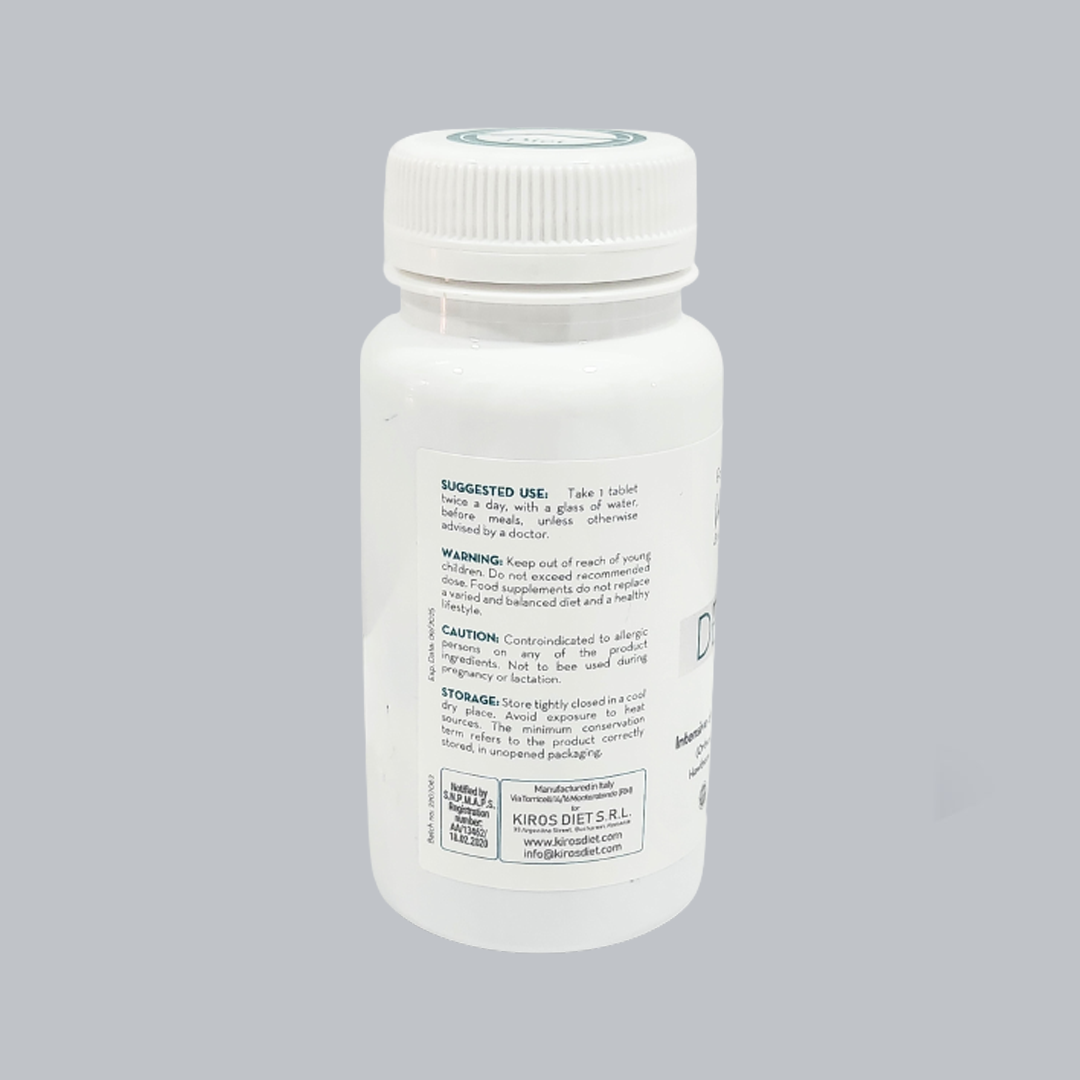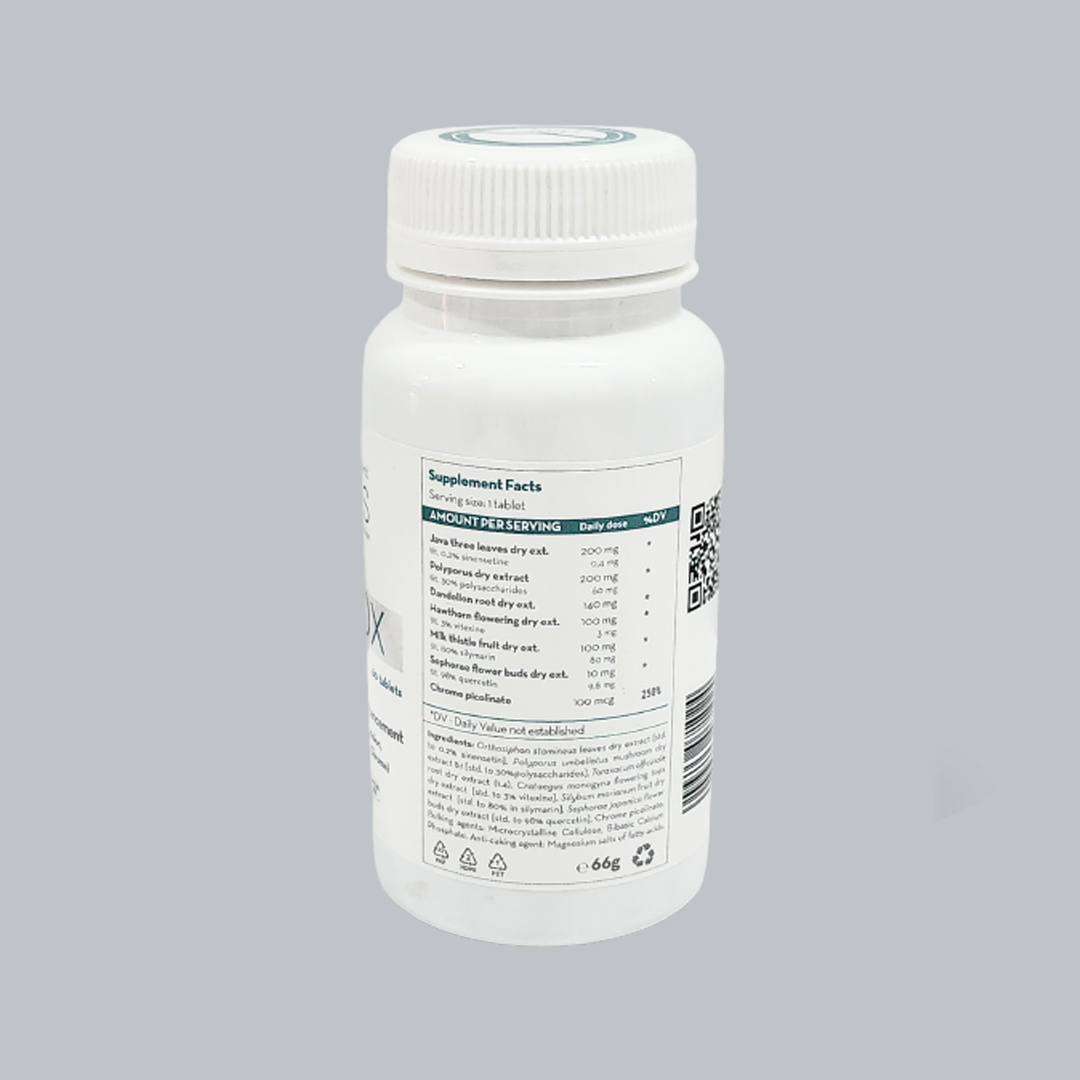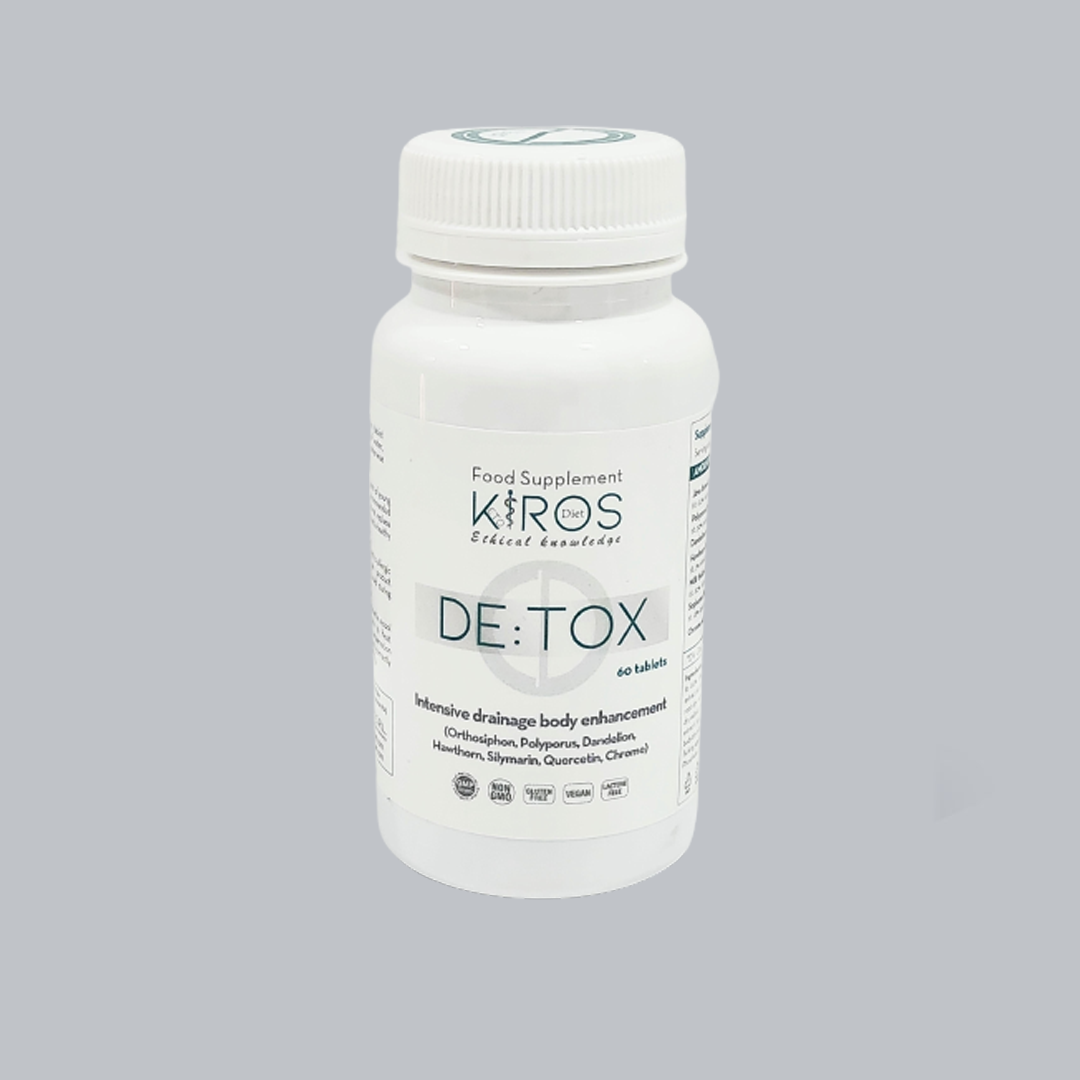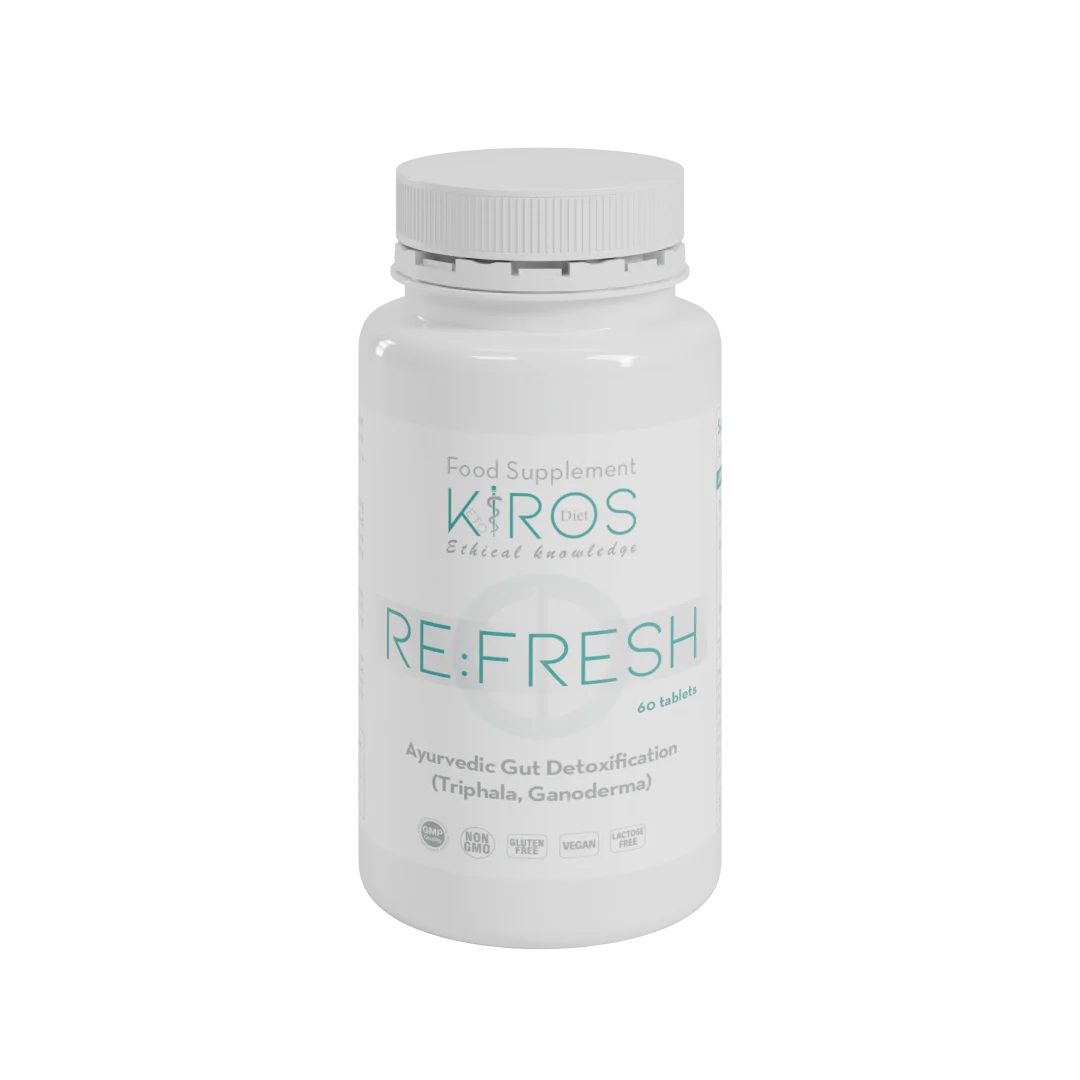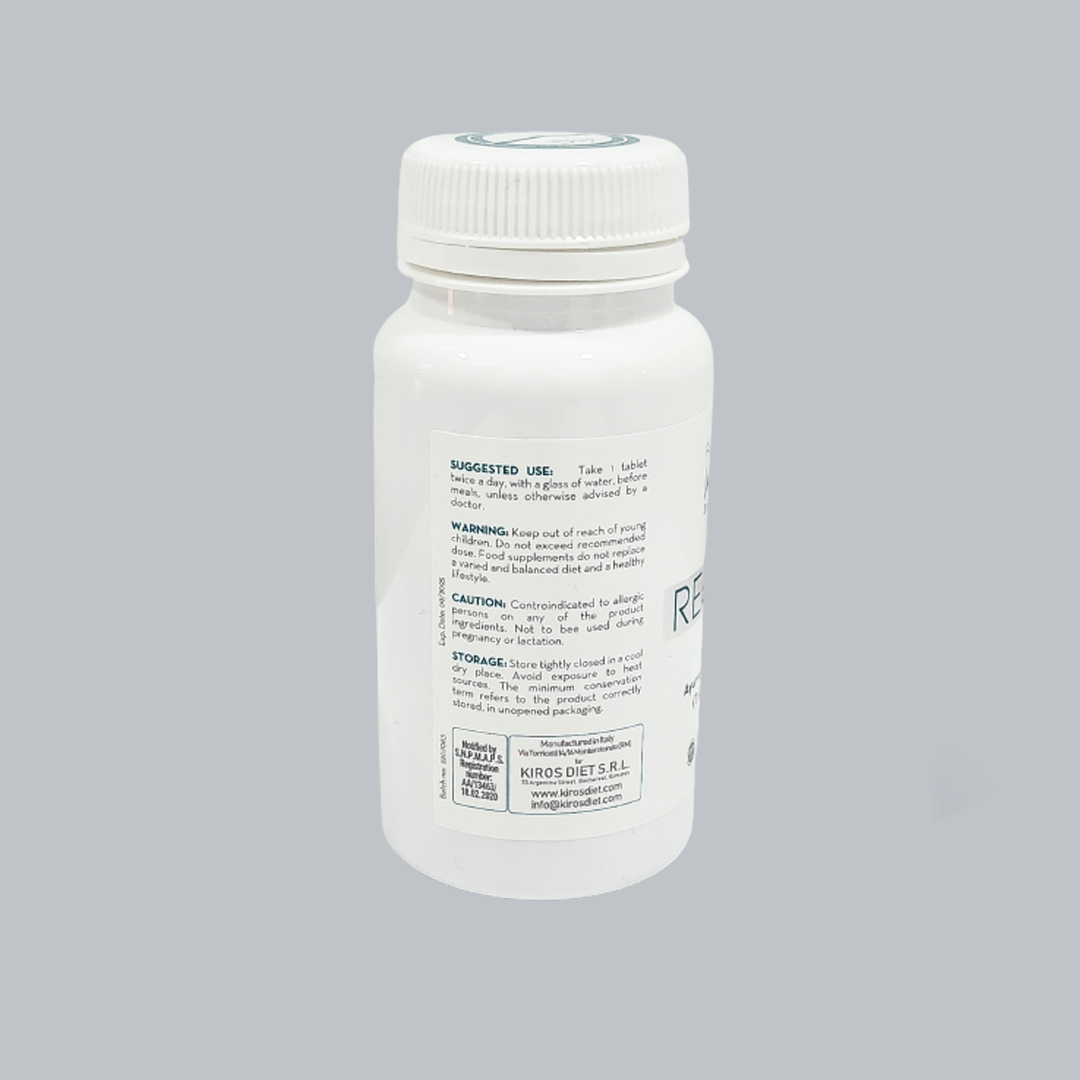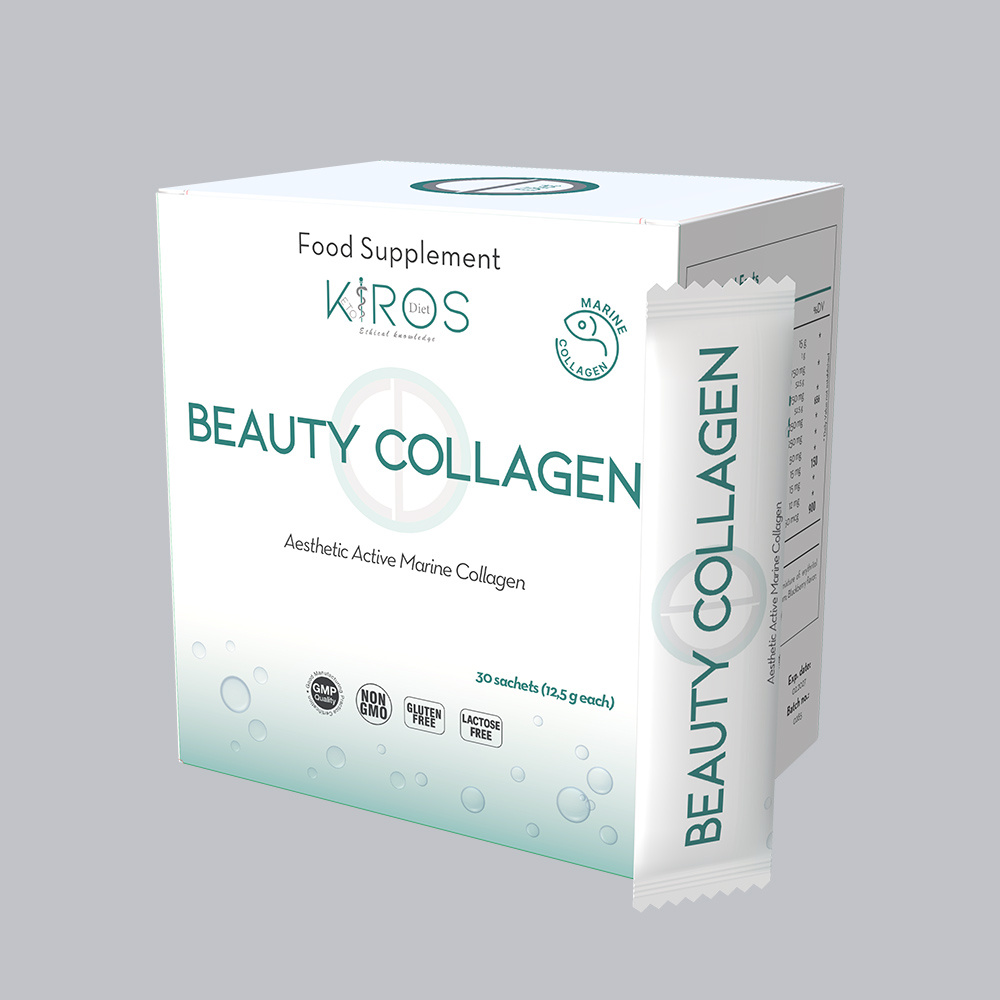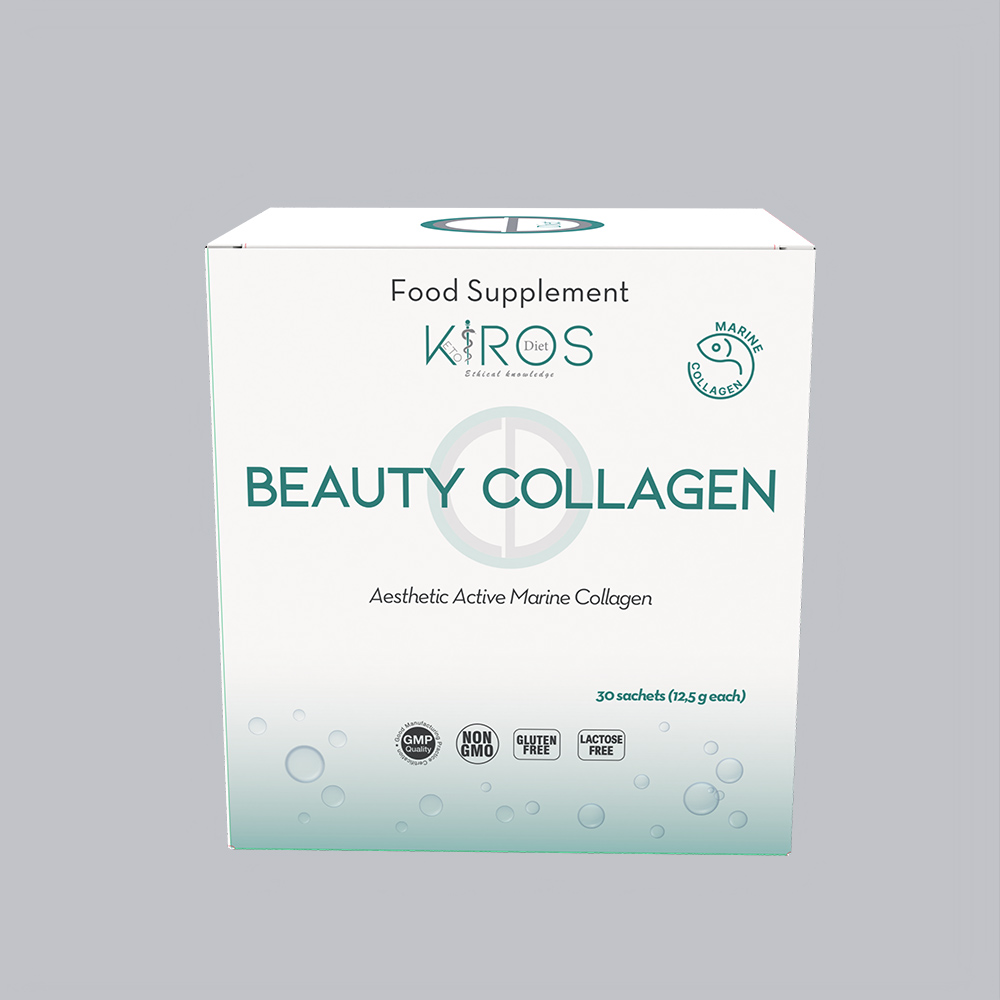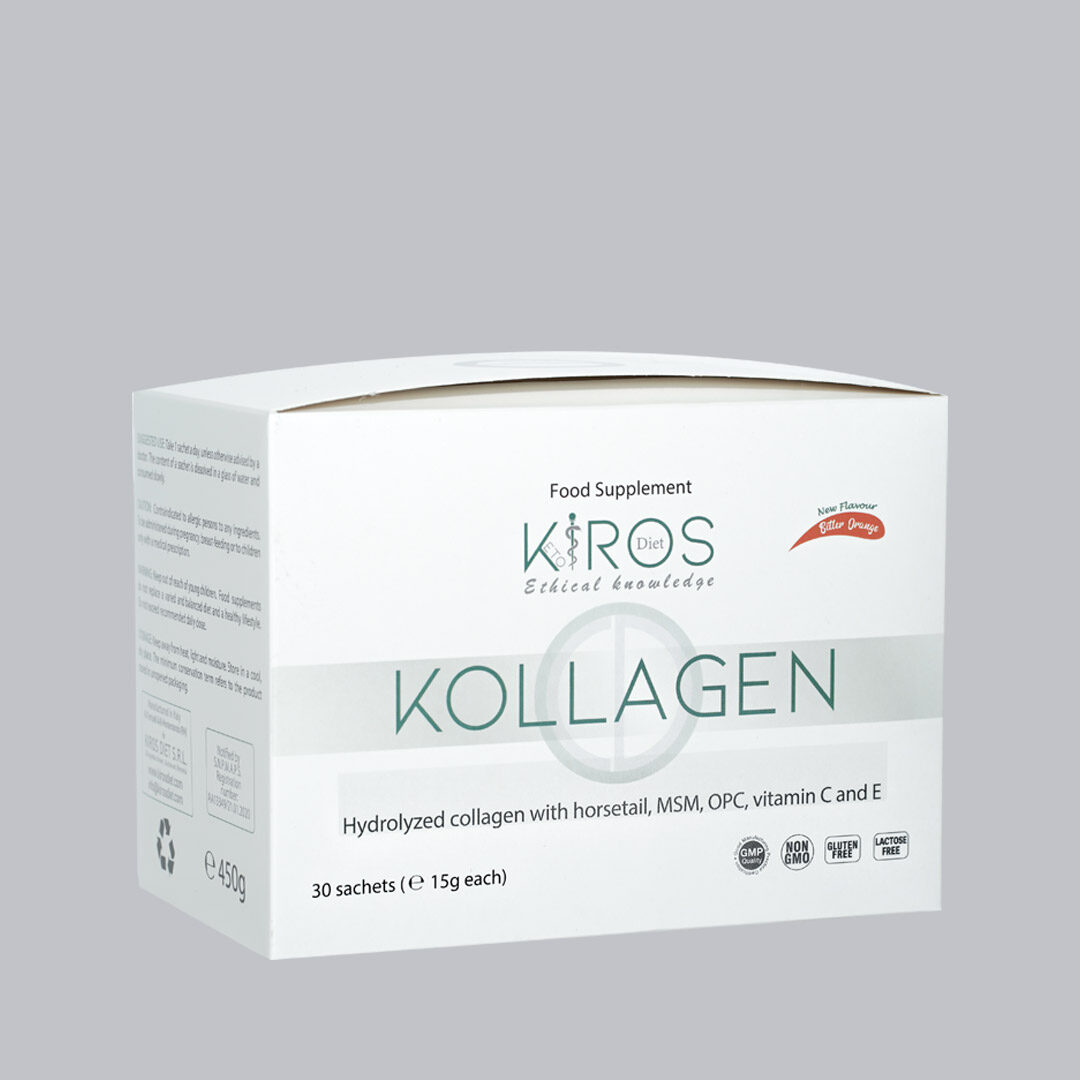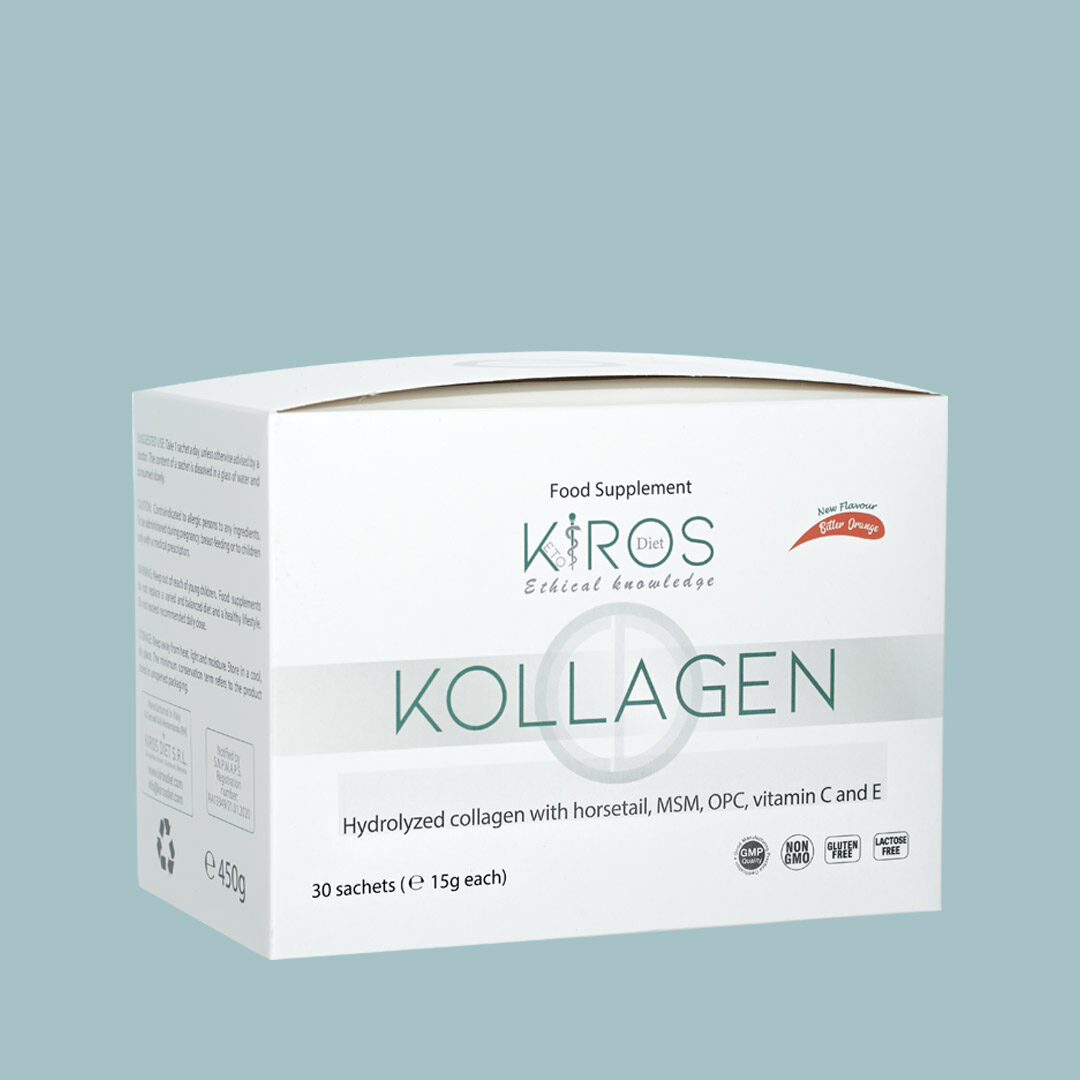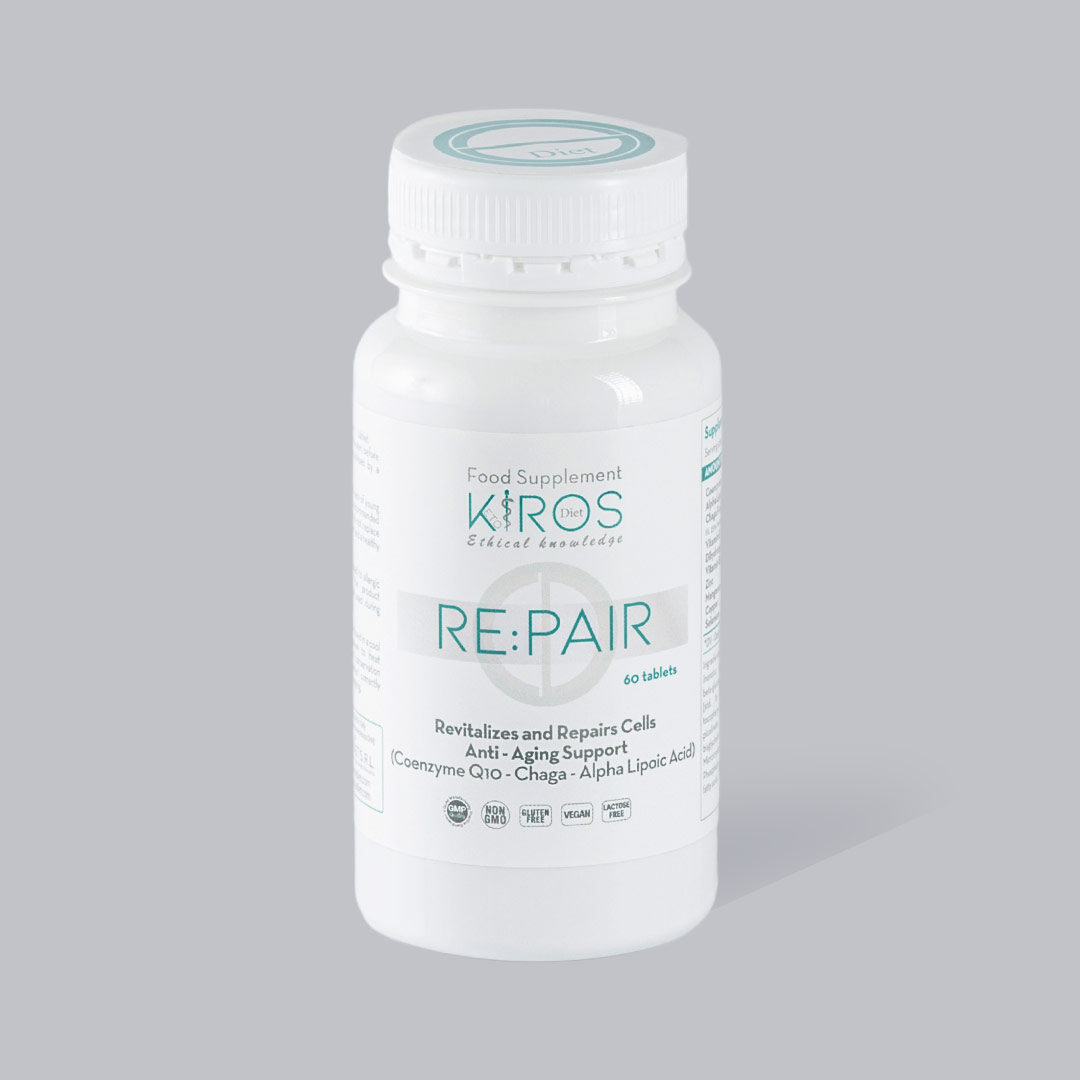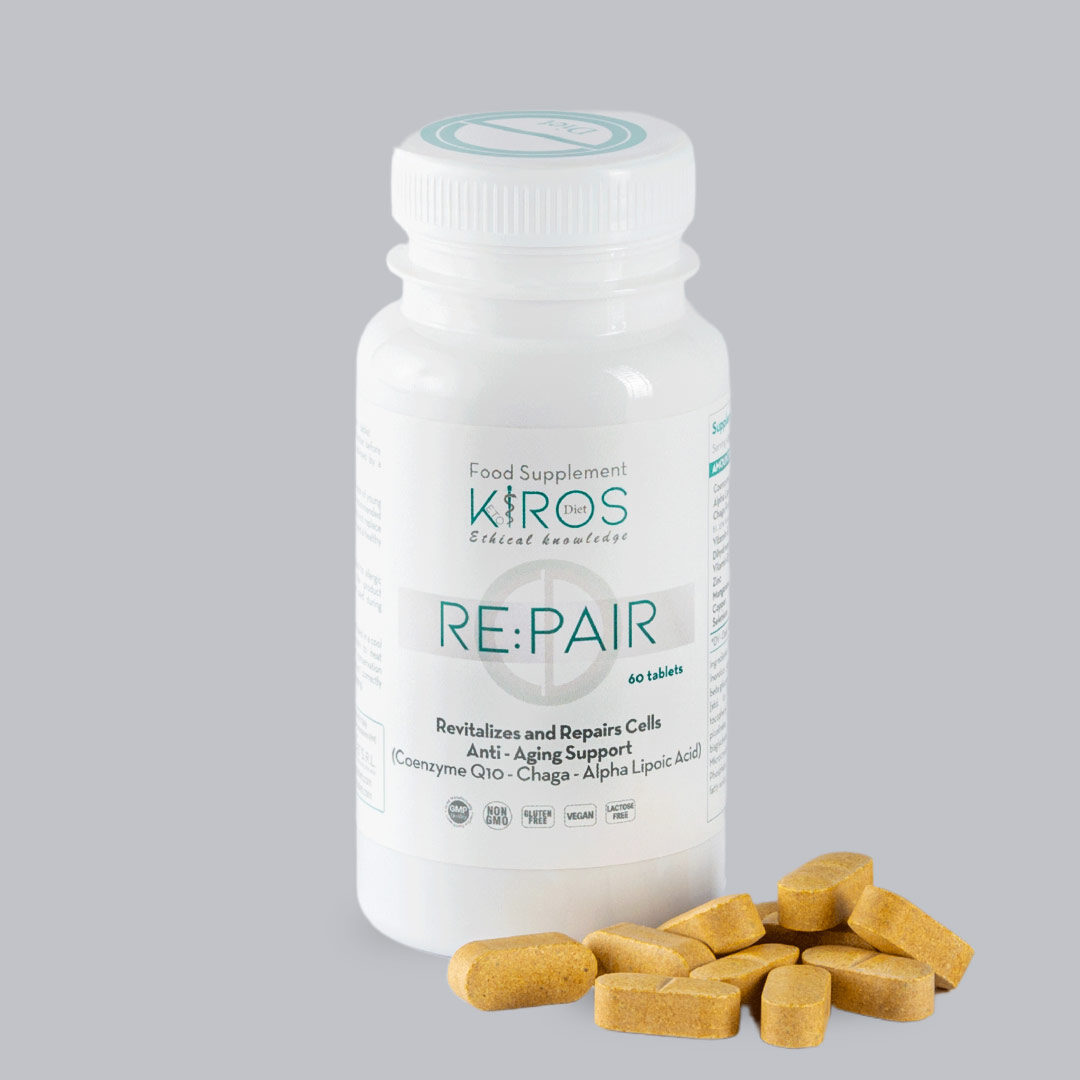Effectiveness
DE:TOX biologically active phytotherapeutic complex, with draining (orthosiphon, dandelion, polyporus), cardiotonic (hawthorn), antioxidant, purifying (milk thistle and quercetin) and metabolic energizing (chromium picolinate, orthosiphon, quercetin) action. The particularly balanced formulation features several medicinal plants, traditionally used to improve circulation and leg well-being.
DE:TOX promotes the physiological process of purification in the body and is particularly indicated in the prevention and treatment of the pathophysiology of water retention, in the prevention and treatment of cellulite, in obese and overweight patients on a restrictive diet as it activates lipid catabolism.
DE:TOX multi-component natural supplement is an activator of microcirculation, promotes fluid drainage, improves the elasticity of the venous walls and their tone, counteracts capillary fragility and gives relief to heavy legs, swollen, tired and fatigued.
Two capsules per day are recommended.
Background
Water retention, a very common phenomenon especially in women, since it is usually related to the hormonal balance typical of the female sex, and is characterized by swelling of the soft tissues of the whole body (not only of the legs), due to the accumulation of fluid in the interstitial spaces, i.e. those portions of tissue located between the cells. It can evolve into lymphedema, an impairment of the lymphatic system that appears when lymph cannot flow adequately towards the heart and stagnates in the tissues, is a harmful phenomenon associated with fluid retention and deposition, weight gain and chronic inflammation as a prelude to other negative conditions for human health.
It has long been known that lymphatic vascularization can be improved by using natural substances and herbs with draining, antioxidant, vasotonic and purifying properties.
DE:TOX is an association of a series of extracts of plant origin that, acting in synergy, stimulate the elimination of excess fluids and improve the microcirculation naturally fighting water retention and helping to keep fit and healthy legs and body.
DE:TOX is useful to improve the conditions of alteration of the lymphatic vascular system and to support the physiological functionality of the lymphatic endothelium.
Efficacy in cellulite
The presence of cellulite is an unacceptable aesthetic problem for most post-adolescent women. It is widely observed in the gluteal-fermal regions with its “orange peel” or “cottage cheese” appearance. It is not specific to overweight women, although increased adipogenicity may exacerbate the condition. It is a complex problem involving the microcirculatory and lymphatic systems, the extracellular matrix, and the presence of excess subcutaneous fat swelling in the dermis. It is necessary to make a distinction between those forms of localized adiposity, improperly defined as cellulite, in which the fat cells are perfectly normal and not altered, and true cellulite, identified by a pathological process. This is a disease that affects not only the fat cells but also the tissue between cell and cell and the smaller blood vessels.
DE:TOX is able to act on different targets:
- skin firmness and elasticity: silymarin, quercetin
- microcirculation activators and vessel protectors: quercetin
- activators of the lymphatic system and promoters of drainage by stimulating diuresis: extracts of orthosiphon, dandelion, Polyporus
- stimulators of adipocytic turnover: orthosiphon, chromium picolinate;
- Detoxifying, antioxidant: extracts of Silybum marianum and hawthorn
Characteristics of components
Polyporus umbellatus extract. In Traditional Chinese Medicine Polyporus umbellatus is indicated for pathologies caused by dampness and stagnation and it is therefore extensively used as a natural diuretic2,3. Polyporus increases urine production and stimulates sodium and chlorine excretion, without a concomitant loss of potassium, which protects muscles and nerves, as it happens with the use of normal diuretics. The polysaccharide extracted from the mushroom has immunostimulant action able to increase the production of immunoglobulin M (IgM) in vivo, that is molecules involved in the immune response of the human body4. DE:TOX contains 200 mg titrated at 30% in polysaccharides.
Orthosiphon stamineus or Java Tea is a plant of Malaysian origin present in subtropical areas of Southeast Asia and Latin America. DE:TOX contains 200 mg per capsule as a dry extract titrated in sinensetin at 0.2%. It is known for its diuretic5 and purifying action and is widely used in all those cases where you want to promote the elimination of water, nitrogenous wastes and uric acid through the urine. It restores the diuresis, increases moderately the urinary volume with activity comparable to the synthetic diuretic furosemide: while the latter increases the excretion of sodium of about 6 times, Orthosiphon doubles it, but reduces compared to the drug the elimination of potassium6 and stimulates in a comparable way the excretion of chlorine. The diuretic action of Orthosiphon extract is also due to a decrease in fluid retention by colloidal substances in the tissues and blood. It also has a mild hypoglycemic, hypotriglyceridemic, choleretic, and cholagogue activity7. It is able to contribute to the reduction of cellulite and localized swelling in addition to eliminating toxins accumulated in the kidneys and liver. In addition, orthosiphon, is suitable for those who suffer from overweight problems or those who have high cholesterol levels.
Dandelion: dandelion root has depurative properties, since it stimulates the biliary, hepatic and renal function by activating the excretory organs (liver, kidney, skin) used for the transformation and elimination of toxins (stool, urine, sweat). The main components of its phytocomplex are triterpene alcohols (taraxerol), sterols, vitamins (A, B, C, D), inulin, bitter principles (tarassacin), which give the plant bitter-tonic and digestive properties, mineral sal inulin. These substances are reported to have depurative, anti-inflammatory and detoxifying properties for the liver: they promote the elimination of waste (sugars, triglycerides, cholesterol and uric acids), making the extract of dandelion a powerful hepatoprotective, indicated in case to hepatic insufficiency, jaundice and gallstones. It also stimulates diuresis by favoring the elimination of excess liquids. Therefore, its assumption is indicated in case of water retention, cellulite and hypertension. Other studies report the immunistimulating action of dandelion, able to improve the immune response of the lymphatic system8 and the capacity to protect from oxidative stress related to atherosclerosis with decrease of atherogenic index9.
Hawthorn: Hawthorn or Crataegus oxyacantha is a shrub very common in temperate areas of the northern hemisphere, of which berries and leaves are used; it contains crategolic acid, flavonoid pigments, glycosides, anthocyanins and terpene derivatives. DE:TOX contains 100 mg per capsule as dry extract titrated in vitexin. This plant has a strong affinity for the heart, mainly related to active polyphenolic compounds: hawthorn has cardiotonic, antiarrhythmic, coronary dilatant, draining and hypotensive properties. Hawthorn decreases the phenomenon related to sympathicotonia and at the same time increases the vagotonic state with a consequent regularization of heart beats; its action is mainly due to the relaxation of muscle fibrocells of the wall of blood vessels. Hawthorn can effectively reduce heart rate, edema and arterial pressure, also showing an action to strengthen the contractile force of the heart, with consequent improvement of water retention and diuresis. Very interesting is its ability to neutralize free radicals, strongly reducing the oxidation of LDL, which tend to deposit in the wall of blood vessels after being oxidized. In this way, it inhibits one of the fundamental events for the formation of atherosclerotic plaques in blood vessels. Numerous experiments and clinical studies have emphasized the cardiovascular efficacy of hawthorn through various mechanisms including increased contractility (positive inotropic effect) and reduced heart rate (negative chronotropic effect), increased coronary blood flow, and exercise tolerance, inhibition of cAMP-phosphodiesterase activity, inhibition of Na+-K+-ATPase activity, inhibition of thromboxane synthesis, stimulation of prostacyclin synthesis, resulting in antioxidant, antihyperlipidemic, and antioxidant activity10. Hawthorn should be used with caution in patients with marked bradycardia (heart rate between 40 and 60 beats per minute) and/or disturbances in electrical stimulus conduction in the heart. It may enhance the activity of positive inotropic and hypotensive medications and may interfere with digitalis therapies.
Silybum marianum is a herbaceous plant that grows in the Mediterranean basin in arid, uncultivated lands. It contains flavolignans (flavonoid derivatives) including silymarin. It is antioxidant, supports digestive and hepatic function and promotes the body’s purifying functions11,12. It is a famous and powerful antioxidant, protecting collagen and elastin from oxidative stress. Numerous studies are reported on its digestive, depurative, cholagogic, gastric stimulating actions. DE:TOX contains 100 mg per capsule as a dry extract with a high silmarine content (80%). Milk Thistle owes its action to the inhibitory action of silymarin on factors responsible for hepatic damage such as free radicals, leukotrienes and mediators of inflammation. Silymarin has antioxidant capacity 10 times greater than Vitamin E. It is an excellent systemic antioxidant that can protect skin cells for healthier skin. Silymarin reduce oxidative stress and reduces the depletion of reduced glutathione which is the antioxidant system most used by skin cells in maintaining the redox balance within them13.
Chromium. Chromium is one of 13 trace elements recognized as necessary for the human body. It is essential for carbohydrate metabolism; in particular, it reduces insulin resistance, improving glucose metabolism and preventing hypoglycemia or diabetes. DE:TOX contains 0.1 mg per capsule as chromium picolinate, a bright red coordination complex derived from chromium and picolinic acid. Dietary sources of chromium are very common foods, such as brewer’s yeast, meat, liver, cheese, whole grains, mushrooms, prunes, asparagus, nuts, wine, and beer.
From the metabolic point of view, chromium seems to be able to enhance the actions of insulin by being part of the so-called glucose tolerance factor, a low molecular weight substance that – by binding to insulin and its receptor – would start the cascade of intracellular events leading to the migration of the pool of glucose transporters from the cytoplasm to the cell membrane.
In diabetic patients, it increases sensitivity to insulin by improving glucose tolerance 14, seems able to enhance the actions of insulin by being part of the so-called glucose tolerance factor, a substance put into circulation by the liver in response to hyperglycemia. Thanks to its role in the formation of glycogen and in the transport of amino acids in the muscle tissue (anabolic action of insulin), chromium is able to increase muscle mass and sports performance. It is credited with the ability to lower cholesterol and triglyceride levels. In fact, symptoms of chromium deficiency include elevated cholesterol and triglyceride levels. Chronic chromium deficiency reduces immune function15. Chromium acts as an enzyme activator and stimulating enzymes involved in glucose metabolism and energy metabolism in general.
Quercetin. Flavonoid with strong antioxidant and anti-inflammatory power, with anti-aging action. Counteracts premature skin aging by neutralizing free radicals, and protecting dermal fibroblasts deputies to the synthesis of collagen and elastin. It plays an important role in the treatment of varicose veins, and symptoms of venous insufficiency, such as night cramps, pain, swelling and heaviness of the legs16. In an in vivo study in Wistar rats quercetin was shown to increase fibroblast proliferation, increase microvessel density, improve reepithelialization and more regular collagen deposition compared to a control group17.
Useful for
DE:TOX is useful for:
Alterations in subcutaneous connective tissue
- hypotonia
- hypotrophy
- aging
- cellulite
- wrinkles and stretch marks
Pathophysiological states that require an increase in drainage activity
- localized and generalized edema
- hypertension
- gout
- intoxication from drugs and foods
- restrictive diets
Alterations in carbohydrate and lipid metabolism
- hyperglycemia
- insulin resistance
- type 2 diabetes mellitus
- metabolic syndrome
Bone tissue alterations
- osteoporosis
Literature
-
Huang, P. L. (2009). A comprehensive definition for metabolic syndrome. Disease models & mechanisms, 2(5-6), 231-237.12 Kobayashi M, Matsui-Yuasa I, Fukuda-Shimizu M, Mandai.
-
Zhao, Y. Y. (2013). Traditional uses, phytochemistry, pharmacology, pharmacokinetics and quality control of Polyporus umbellatus (Pers.) Fries: a review. Journal of ethnopharmacology, 149(1), 35-48.
-
Zhao, Y. Y., Xie, R. M., Chao, X., Zhang, Y., Lin, R. C., & Sun, W. J. (2009). Bioactivity-directed isolation, identification of diuretic compounds from Polyporus umbellatus. Journal of ethnopharmacology, 126(1), 184-187.
-
Dai, H., Han, X. Q., Gong, F. Y., Dong, H., Tu, P. F., & Gao, X. M. (2012). Structure elucidation and immunological function analysis of a novel β-glucan from the fruit bodies of Polyporus umbellatus (Pers.) Fries. Glycobiology, 22(12), 1673-1683.
-
Adam, Y., Somchit, M. N., Sulaiman, M. R., Nasaruddin, A. A., Zuraini, A., Bustamam, A. A., & Zakaria, Z. A. (2009). Diuretic properties of Orthosiphon stamineus Benth. Journal of Ethnopharmacology, 124(1), 154-158.
-
Singh, M. K., Gidwani, B., Gupta, A., Dhongade, H., Kashyap, P. P., & Tripathi, D. K. (2015). A review of the medicinal plants of genus Orthosiphon (Lamiaceae). Int J Biol Chem, 9, 318-31.
-
Seyedan, A., Alshawsh, M. A., Alshagga, M. A., & Mohamed, Z. (2017). Antiobesity and lipid lowering effects of Orthosiphon stamineus in high-fat diet-induced obese mice. Planta medica, 83(08), 684-692.
-
Choi, U. K., Lee, O. H., Yim, J. H., Cho, C. W., Rhee, Y. K., Lim, S. I., & Kim, Y. C. (2010). Hypolipidemic and antioxidant effects of dandelion (Taraxacum officinale) root and leaf on cholesterol-fed rabbits. International journal of molecular sciences, 11(1), 67-78.
-
Choi, U. K., Lee, O. H., Yim, J. H., Cho, C. W., Rhee, Y. K., Lim, S. I., & Kim, Y. C. (2010). Hypolipidemic and antioxidant effects of dandelion (Taraxacum officinale) root and leaf on cholesterol-fed rabbits. International journal of molecular sciences, 11(1), 67-78.
-
Orhan, I. E. (2018). Phytochemical and pharmacological activity profile of Crataegus oxyacantha L.(hawthorn)-A cardiotonic herb. Current medicinal chemistry, 25(37), 4854-4865.
-
Bahmani, M., Shirzad, H., Rafieian, S., & Rafieian-Kopaei, M. (2015). Silybum marianum: beyond hepatoprotection. Journal of evidence-based complementary & alternative medicine, 20(4), 292-301.
-
Freitag, A. F., Cardia, G. F. E., da Rocha, B. A., Aguiar, R. P., Silva-Comar, F. M. D. S., Spironello, R. A., … & Cuman, R. K. N. (2015). Hepatoprotective effect of silymarin (Silybum marianum) on hepatotoxicity induced by acetaminophen in spontaneously hypertensive rats. Evidence-Based Complementary and Alternative Medicine, 2015.
-
Svobodová, A., Zdařilová, A., Mališková, J., Mikulková, H., Walterová, D., & Vostalová, J. (2007). Attenuation of UVA-induced damage to human keratinocytes by silymarin. Journal of Dermatological Science, 46 (1), 21-30.
-
Sala, M., Breithaupt, L., Bulik, C. M., Hamer, R. M., La Via, M. C., & Brownley, K. A. (2017). A double-blind, randomized pilot trial of chromium picolinate for overweight individuals with binge-eating disorder: effects on glucose regulation. Journal of dietary supplements, 14(2), 191-199.
-
Orhan, C., Kucuk, O., Tuzcu, M., Sahin, N., Komorowski, J. R., & Sahin, K. (2019). Effect of supplementing chromium histidinate and picolinate complexes along with biotin on insulin sensitivity and related metabolic indices in rats fed a high‐fat diet. Food science & nutrition, 7(1), 183-194.
-
Long, X., Zeng, X., Zhang, F. Q., & Wang, X. J. (2006). Influence of quercetin and x-ray on collagen synthesis of cultured human keloid-derived fibroblasts. Chinese medical sciences journal, 21(3), 179-183.
-
Gopalakrishnan, A., Ram, M., Kumawat, S., Tandan, S. K., & Kumar, D. (2016). Quercetin accelerated cutaneous wound healing in rats by increasing levels of VEGF and TGF-β1. NISCAIR Online Periodicals Repository, 187-195
